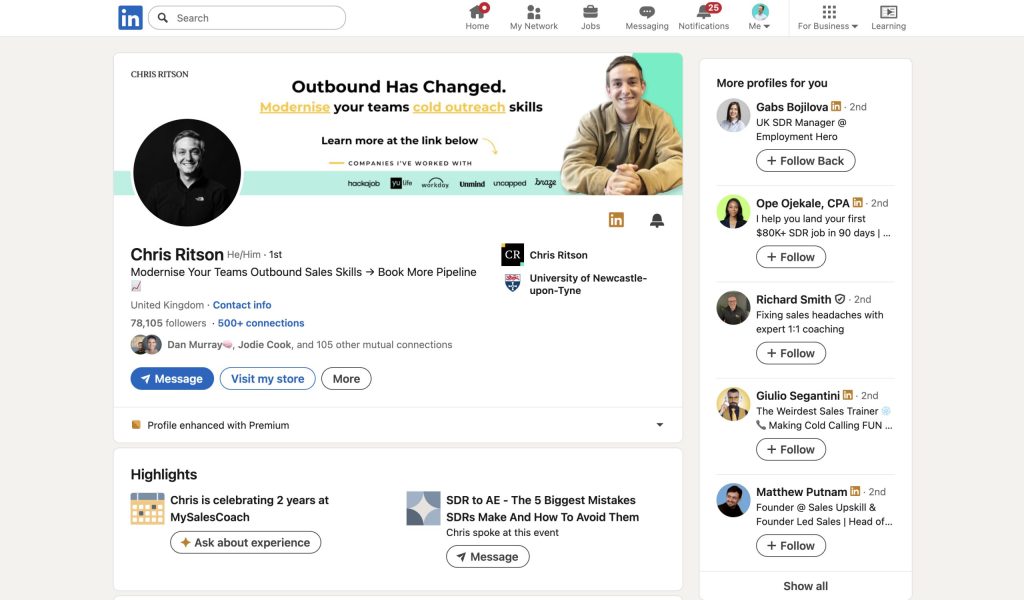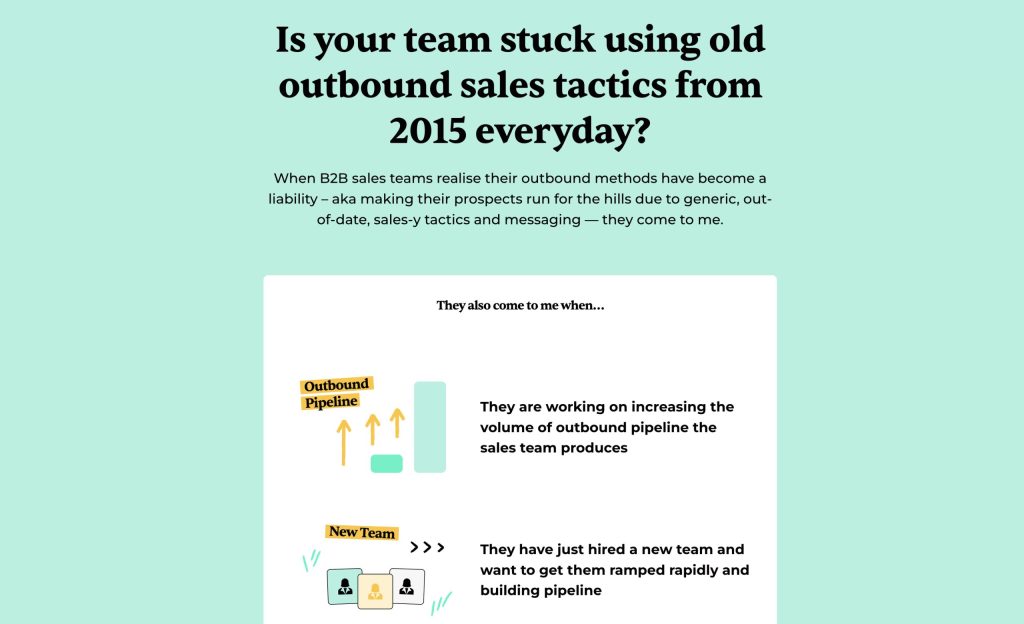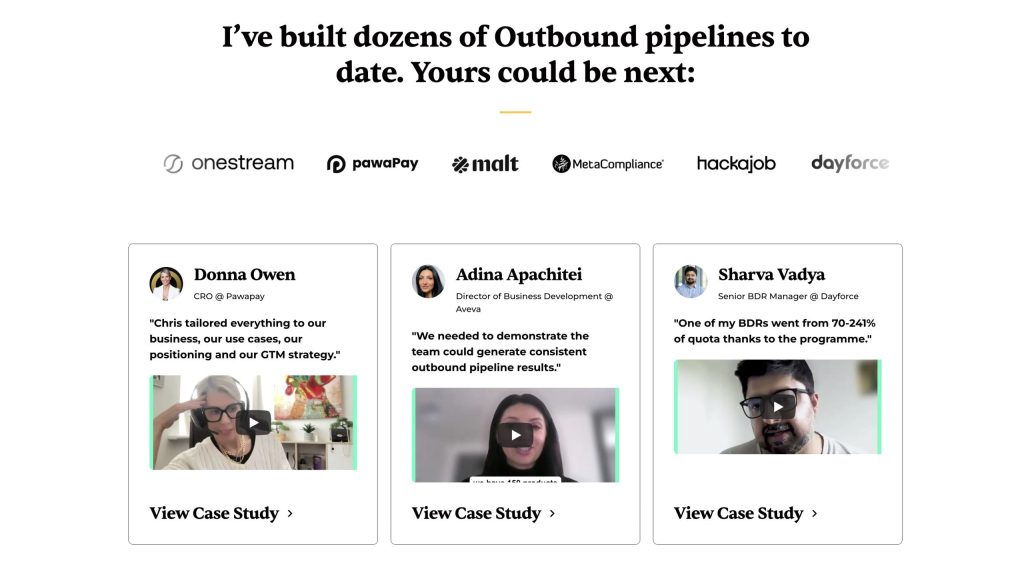Transforming a Training Business: 2X Revenue With 50% Less Work in 12 Months

How do you create a true lifestyle business — one that you love and thrive in? A business that generates a steady income and allows plenty of family time?
That was Chris Ritson’s goal when he reached out in 2024.
This case study captures the journey that unfolded over the following year.
Chris Ritson is a solopreneur and sales trainer. His online education business focuses on two key areas:
- Teaching junior Sales Development Representatives (SDRs) foundational sales skills
- Training SDR managers to build successful, high-performing teams.
(Find him here: https://chrisritson.xyz/)
At first glance, Chris seemed to be doing fine when we met.
His 3-year-old business was already generating $300k+ revenue from high-ticket consulting and regular bootcamps.
Trouble was, he was trapped in a cycle of working harder than ever, with a growing fear that his business was turning into something he would come to resent.
Under the surface, Chris’s business was:
- Heavily reliant on cold outreach and a scattershot email list
- Caught in a cycle of underpricing and over-delivery
- Not generating a regular income
- Constantly in launch mode
He was torn between balancing time with his family and chasing the money to sustain that dream.
“I was terrified of building a business that I didn’t actually love, and redirecting that energy of not loving it back to my family.”
As I see with so many entrepreneurs, Chris’s early business decisions had painted him into a corner. Each logical choice created constraints that needed his constant presence, so Chris couldn’t scale without burning out.
When we first talked, he was caught between two impossible choices:
1. Continue the relentless pursuit of bigger deals — sacrificing the family time that motivated him to start the business in the first place
OR
2. Scale back and risk financial instability — potentially losing everything he’d worked to build
The biggest challenge of all?
He couldn’t see a path that would give him both financial security and the lifestyle he craved.
Each option seemed to require sacrificing one for the other.

These were the obstacles that blocked Chris from achieving his dream business:
1. A Stressful Business Model
Chris found his business highly stressful.
This was caused by a few things…
a. Over-reliance on high-ticket deals
Chris had trained teams during his corporate career, and he still focused much of his time and energy on delivering high-ticket team training within individual firms.
Those trainings generated 75% of his revenue, making him “extremely reliant on closing big deals.” Securing each job meant spending way too much time on cold outreach.
And it created a feast or famine revenue cycle.
“The year before we started working together I closed $320,000 in revenue. Over $240,000 of that was in live team training. That was the sole determinant of whether I had a good month or not within the business. Nothing was consistent.”
b. Customer journey didn’t make sense
Although he focused on team trainings, Chris had two other offerings:
- One digital product (seldom promoted)
- Online bootcamps (held every 2-3 months)
Originally, Chris assumed each product would lead customers into the next. In reality, each product was aimed at a vastly different market.
“I had one digital product that flows into a bootcamp that flows into potentially some team training, but they’re all different ICPs so it just didn’t make logical sense.”
A junior salesperson represents the problem perfectly.
They might buy a low-cost digital product. But they’re unlikely to make the jump to an expensive bootcamp, and authorising a team training is well above their pay grade.
Running bootcamps every 2-3 months creates other problems, too.
Each bootcamp takes a tonne of work, and running them so often could be a fast track to burnout.
Chris found himself stuck in launch mode — promoting the same thing to the same people, with less and less impact each time.
2. Financial Hamster Wheel
“I would go into every month on zero. That was humbling. You’d have a good month, close a big deal, and then you’d be like, okay, I’m back on zero; back to the grind.”
There were two causes of this…
a. Pricing
Chris had fallen into the classic trap of undercharging and overdelivering.
Sure, he was charging around £20k for team training. But once he sat down and crunched the numbers a different story emerged.
Hours and hours spent on cold outreach, prep and delivery — not to mention the extra sessions he piled on to justify the fees in his own eyes. The only thing they did was dilute the quality of his work and erode his confidence in what he was worth.
Adding it all up showed his actual hourly rate was far lower than he’d thought.
And he still lacked a predictable monthly income.
b. Inconsistent income
In some ways, the income rollercoaster was the most exhausting.
Even after a great month, he’d be back to square one. This lack of predictable monthly income created a constant undercurrent of financial stress.
”Because I was in a state of semi-consistent worry and panic about revenue my gaze was constantly drawn to the high ticket.”
3. Strategic Mindset
Chris faced fundamental strategic challenges, too.
The business lacked a foundational product that could be generating regular sales in the background to provide stability.
Coming from a B2B corporate background, he didn’t know where to begin when it came to B2C marketing. He felt trapped in a transactional mindset, spending hours on cold outreach rather than trying to build a systemic, long-term audience.
At the same time, that lack of consistent income — together with an underlying imposter syndrome mindset — made him reluctant to invest in himself or his business.
Constantly torn between the need for an income and the terror of building a business he didn’t love — and how that would impact his family — Chris felt trapped by his current approach and couldn’t see a way forward.
INSIGHT FROM olly:
Chris’s story is a great example of why so many entrepreneurs stay stuck. Instead of seeing the bigger picture, they’re trapped in a transactional mindset, simply trying to survive.
Half the battle is understanding what strategy makes sense.
So, Chris spent hours doing cold outreach—not because it was the smartest option, but because he didn’t know what else to try. He undercharged and over-delivered—not out of generosity, but because he wasn’t sure how to position his value.
As we’ll see, the real breakthrough came when he stepped back and asked the bigger questions:
- Who exactly am I helping?
- What’s the step-by-step journey they take with me?
- And how can I build systems that keep working, so I don’t have to hustle nonstop?
Getting clear on your strategy is half the battle. Once you have that, the rest gets a lot simpler.
The Work
Let’s summarise:
- Chris’s new business was generating $300,000, but monthly income was wildly inconsistent
- Each product spoke to a different customer profile, so there was limited potential for upselling
- Chris tended to under-price and over-deliver, especially during team trainings
- A transactional mindset led to unfocused marketing and promoting to a generic email list
- Chris constantly pulled between what seemed to be opposing forces: lifestyle vs finance.
So, we needed to:
- Create predictable monthly revenue streams
- Align his offerings around a single customer journey
- Build the confidence to charge premium prices while delivering focused, high-impact results instead of over-delivering
- Shift from transactional cold-outreach to systematic audience building that would generate consistent leads over time
- Design a business model that prioritised lifestyle without sacrificing financial growth
We weren’t going to get there by tweaking the business.
The only way we would reach Chris’s goal is by totally reimagining the business – what it does and how it operates.
Chris wanted to leave behind the stressed-out consultant persona and create the lifestyle business he’d imagined—one with steady income, multiple revenue streams, and the freedom to choose the projects that mattered most.
To get there, we tackled each challenge with a clear strategy.
Here’s what we did…
1. Created Consistent Income
One obvious challenge was Chris’s over-reliance on high-ticket training.
Not only did that create rollercoaster income highs and lows but only he could deliver those courses.
We needed to:
- Diversify his income
- Create a foundational income stream which could operate on automatic.
Our plan?
- Create several affordable digital courses, targeted at junior sales representatives. (The largest audience and those most likely to buy.)
- Implement systematic promotions so that those courses could sell consistently with minimal input from Chris.
- Realign lead magnets so they highlighted the right product to each subscriber.
Once created, these courses could create a foundational revenue stream for the business, providing a reliable income that didn’t require Chris’s constant presence.

2. Marketing and Audience-Building Strategy
Chris was over-reliant on cold calling big companies and “didn’t know what to do with” his sole digital course.
What’s more, although he had 3 different offerings, he couldn’t speak directly to any one part of his target market because his email list wasn’t segmented.
His communication was a “one size fits all” approach, which is never optimal.
Once Chris improved his digital products so they provided a regular income he wouldn’t be so reliant on team training.
At the same time, he needed to change his content marketing strategy.
By writing content for specific groups, he could bring them into his email list and significantly cut back on the hours spent cold outreach.
I was in a very transactional, cyclical state of mind — reach out, book a meeting, run the deal process, close the deal, then move on to the next one.You guided me to create a much longer-term model for how I marketed. So, building and nurturing an audience over long periods of time, and being able to convert that into revenue.
3. Bootcamp Transformation
Chris ran live bootcamp sessions over several weeks, helping cohorts of SDRs (Sales Development Reps) gain the skills they needed for promotion.
These still required Chris’s constant presence and input but seemed less intense than his corporate offers. So Chris planned to start a new cohort every 2-3 months.
My opinion?
On paper, 4–6 bootcamps a year seems doable. But in practice, Chris would always be stuck in launch mode. To me, that’s an unsustainable recipe for exhaustion and burnout.
It wouldn’t leave space for other areas of the business to develop.
And it still wouldn’t supply the passive income he was looking for.
Bootcamps should be a vital middle tier. Ideally aimed at SDRs looking for advancement they needed to slot neatly between the affordable SDR digital courses and premium corporate training.
What’s more, pricing them too cheaply affected the effort bootcampers put into their training:
“I realised people were only 75% invested. But you need them 100% in, because otherwise they’re not going to get the results. Then that becomes a brand issue.”
So we planned to double the price per seat and gradually move from 3-monthly to 6-monthly starts.
Together, those changes would earn the same revenue but ease the workload and reduce stress.
4. Team Training Changes
Each team training involved intense effort from Chris. However, their relatively cheap price (by corporate standards) meant people didn’t fully invest in the process.
At the same time, Chris underestimated the value of his experience and material. It left him constantly trying to add extra layers to increase the perceived value.
In fact, it had the opposite effect.
“I often felt like I just needed to give more sessions to make my customers feel like the whole package was more, basically. 75% of the way into a bespoke programme, I would think; ‘they’re ready. I think we’re there. But I’ve already committed to another six or eight sessions, so let’s find some more stuff to do.’That dilutes the entire quality of the work I’m delivering.”
To counter all these challenges we planned several changes.
Chris needed to:
- Create predictable monthly revenue streams
- Align his offerings around a single customer journey
- Build the confidence to charge premium prices while delivering focused, high-impact results instead of over-delivering
- Shift from transactional cold outreach to systematic audience building that would generate consistent leads over time
- Design a business model that prioritized lifestyle without sacrificing financial growth
INSIGHT FROM olly:
Chris’s pricing highlights a common challenge for entrepreneurs: undercharging doesn’t just limit your income, it can quietly erode the foundation of your business.
You feel as if you’re charging the earth, and fall into the trap of over-delivering to justify the price.
But the extra effort spreads you thin and chips away at your confidence. The time you put into the job lowers your effective hourly rate and leaves you scrambling to take on even more work just to stay on track financially.
The result is a familiar cycle:
– constant stress about revenue- inconsistent income- a tendency to accept every project just to keep things moving.
It’s a pattern that keeps you stuck in survival mode instead of building something sustainable.
The counterintuitive solution? Raise your prices.
By charging more you can be more selective in choosing the clients to work with. And because they’re your ideal clients, you can deliver exactly what they need.
You build confidence in yourself and your abilities which in turn attracts better opportunities. What’s more, people value what they pay for. So when clients pay more, they put more effort into achieving the best results.
As we’ll see, for Chris this shift made all the difference — proving that pricing isn’t just about numbers. It also sets the perception of excellence and the foundation for long-term growth.
Our Results
Chris set out to grow a lifestyle business that allowed plenty of time to spend with family. But when we first connected, his business model clearly wasn’t sustainable.
He found himself stuck in a cycle of constantly finding and running corporate team training courses.
Each course had a sizeable fee, but there was no telling when the next contract would land. Without a steady income, Chris felt stuck — constantly ‘on’ in the business, with his family time taking the hit.
So, I recommended he focus on:
- Creating predictable revenue streams
- Aligning each offering around a single customer journey
- Changing his pricing structure
- Systematically building an audience that would generate consistent leads over time
Each change would move Chris closer to a business that balanced family freedom with financial growth.

Profitability
Here’s where we landed a year later…
Chris’s overall business revenue more than doubled, from $320,000 to $680,000.
We achieved this by pulling four big levers:
- Digital course revenue jumping from £500 to £7000 a month and tracking towards £100k+ annual revenue
- Bootcamps — the average order value (AOV) doubled per seat
- Team Training — increased more than 30% per contract
- Improved Marketing — increased efficiency across the board
Improvements like these have turned Chris’s dream of a lifestyle-focused, family-first business into reality.
“That’s the essence of what I wanted to achieve with the business: to be able to create memories and be there for my kids. Having them grow up with me around, as opposed to me on a plane or in a hotel in some random country around the world instead.”
Here’s how Chris achieved these dramatic results.
1. Business Model Transformation
Instead of relying on high-ticket consulting we diversified Chris’s revenue streams.
We diversified the revenue streams so Chris was no longer relying on high-ticket consulting to fund the business.
Now it boasts a balanced mix of digital products, bootcamps, and team training, providing a variety of revenue stream from different segments of his audience.
This makes for a stable business that can weather a storm.
a. Developed Digital Courses
Chris created a series of affordable digital courses to help SDRs upskill, improve their performance, and earn promotions — then deliberately marketed them to that audience.
“I had done the classic thing of: I’ve launched it, now what the hell do I do with this? Because surely people will just go on my website and buy it? Now I’ve realigned all my lead magnets to push the right products to subscribers depending on what they actually subscribe to.”
With more targeted products, stronger lead magnets, and a consistent email strategy, Chris is attracting better-fit leads—people already looking for solutions and ready to buy.
The whole system runs on automatic, so SDRs can buy the right course without needing Chris to be involved each time.
Now these digital courses form the backbone of his business.
Having reliable passive income has taken a lot of pressure off. Meanwhile, he’s managed to grow the business without heavy spending or hiring any full-time staff.
b. Optimised Bootcamps
“I think this is the part that really helps me differentiate from other people in the sales training enablement space, because it’s essentially 9 hours of FaceTime with me.”
Chris’s first bootcamps were too cheap and ran too often. It made for an unsustainable workload, which left him feeling as if he was in a permanent launch mode.
Our solution:
Increase the price per seat and cut back the frequency.
Now each bootcamp runs every 4–6 months (half as much as before) and attracts 40–50 participants. This seemingly simple move maintains bootcamp revenue but significantly reduces the workload.
The unexpected bonus?
Having fewer camps means Chris promotes them less often, so he’s not annoying his audience by “promoting the same thing all the time.” Chris has noticed a significant increase in the quality and commitment of bootcampers joining the course.
“Double the price per seat, but half the amount that I’m running. So I’m making the same amount of money from doing half the amount of work.The coolest thing about the price increase has been the quality of the customer that’s now coming through. People are really serious. They spend their own money and they spend lots of it. And then they turn up and they give it everything.”
c. Improved Bespoke Team Trainings
By increasing the prices on his in-house training by 30%, Chris significantly boosted his revenue.
He now charges what his one-on-one time is truly worth and focuses on delivering quality not quantity.
“I’m doing 25% less work on average. Because, let’s say they’re going from 10 weeks to eight weeks. We’re doing the same amount, but for more money. So the actual per hour cost is significantly bigger.”
That hasn’t just boosted revenue — it’s also allowed him to be more selective.
In the past, he onboarded every client he could get. Now, he focuses on clients who align with his values and refers the rest to others in his network.
It makes each training more valuable for the clients and more fun for Chris.
It means he’s also stopped stretching out sessions just to hit a number. Now, if the team’s ready, they’re good to go. It’s all part of a new, more confident approach that prioritises impact over fluff.
“I’m not over-delivering anymore, especially from a coaching, training and teaching perspective. I’ve got a little bit more belief in the quality of each session, each workshop, each part of the product that I deliver and the value of each one, as opposed to thinking more equals more value.”
d. Focused Marketing Engine
Chris’s shift from cold outreach to audience building wasn’t just tactical—it was transformative.
Rather than outsourcing his content, Chris has kept his newsletter and publication in his own hands.
“But two of the most impactful decisions that you guided me towards was ‘continue building your audience every day, and continue writing your own newsletter. Don’t give that to anyone else.”
That decision, though small at the time, has turned out to be one of the most impactful. Creating and publishing regularly deepens his understanding of his business and his audience—and is now a key driver of revenue.
Now he starts building relationships with potential clients early, so when he’s on a call they already understand his value.
“I was focusing, you know, a couple of hours of my day on cold outreaching people. It was this very transactional state of mind… whereas what you guided me towards focusing on was building a much longer term model for how I went to market.”
Now, Chris’s systems tick over in the background.
That audience-focused marketing engine brings in warm leads and supports his long-term growth—without the constant stress — even when he’s offline or spending time with family.
INSIGHT FROM olly:
Many consultants start by selling their expertise 1:1.
It’s what they know, and it works. But this model has a ceiling. You only have so many hours, and raising your rates or taking on more clients just keeps you stuck on the expertise hamster wheel.
This was the trap Chris had fallen into — trading time for money. The breakthrough came when he turned his knowledge into digital products and repeatable systems. That shift gave him more predictable income and freedom to be selective with clients.
This isn’t a question of giving up premium work—it’s about building a base that runs in the background. With multiple revenue streams, Chris now enjoys a more scalable, sustainable business. Many consultants don’t take this step. But those who do unlock real freedom.

Has Chris Achieved His Lifestyle Business Dream?
Remember Chris’s fears back at the start?
Of the business running him ragged instead of providing the family lifestyle he craved?
Did he turn that around?
Yes — Chris and his family are living the dream, while he builds a sustainable business he can truly love.
This year, we went to Japan and Korea for a month. We went out during the day and I worked a couple of hours in the evenings. To have a system in place where the business is actually moving, revenue is still coming in and I can dial it down to an hour or two a day to do this insane family trip was ridiculous, right? And to get to that point so quickly is not to be underestimated. No one’s ever going to take that away from me.That’s actually the essence of what I wanted to achieve with the business. To be able to create memories and be there for my kids and for them to grow up with me around, as opposed to me on a plane or in a hotel in some random country around the world instead. For me, that’s the real juice.
A lot can change when you align your business with the life you actually want.
Chris is living proof.
To find out more about mentorship with Olly, or to read more case studies, click here.